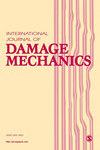Three-phase damage model based on composite mechanics for post-peak analysis of recycled aggregate concrete
IF 3.9
2区 工程技术
Q2 MATERIALS SCIENCE, MULTIDISCIPLINARY
引用次数: 0
Abstract
This paper presents a novel three-phase damage model for the prediction of the post-peak responses of composite materials, such as recycled aggregate concrete (RAC). The proposed damage model is based on composite damage mechanics and is composed of three phases: cement paste, interface transition zone (ITZ), and aggregate. All phases are assumed to be linearly elastic and isotropic materials. The aggregate is supposed to be the undamaged material, while the cement paste and ITZ are considered the damaged materials. Three different composite damage models, namely Voigt (parallel), Reuss (serial), and the proposed generalized self-consistent (spherical), represent the damage growth in the composite materials. The Voigt parallel model is employed to address the upper bound of post-peak stiffness and stress, while the Reuss serial model represents the lower bound. To investigate the softening phenomenon after the post-peak state, both linear and exponential functions are used to describe the stress-strain curve in this state. Two numerical simulations are provided to examine the stress degradation in the softening state. Both simulations reveal that the post-peak stress degrades with increasing damage parameters and ITZ thickness. Therefore, both damage and ITZ’s thickness are significant factors for analyzing the post-peak responses of RAC.基于复合力学的再生骨料混凝土峰后分析三相损伤模型
本文提出了一种新的三相损伤模型,用于预测复合材料(如再生骨料混凝土)的峰后响应。提出的损伤模型基于复合损伤力学,由水泥浆体、界面过渡区和骨料三个阶段组成。所有相均假定为线弹性和各向同性材料。骨料为未损坏材料,水泥浆体和ITZ为损坏材料。Voigt(平行)、Reuss(连续)和本文提出的广义自一致(球面)三种不同的复合材料损伤模型代表了复合材料的损伤增长。采用Voigt并行模型求解峰后刚度和应力的上界,采用Reuss串行模型求解峰后刚度和应力的下界。为了研究峰后状态后的软化现象,采用线性函数和指数函数来描述峰后状态下的应力-应变曲线。提供了两个数值模拟来研究软化状态下的应力退化。两种模拟结果均表明,峰值后应力随损伤参数和ITZ厚度的增加而降低。因此,损伤和ITZ厚度都是分析RAC峰后响应的重要因素。
本文章由计算机程序翻译,如有差异,请以英文原文为准。
求助全文
约1分钟内获得全文
求助全文
来源期刊

International Journal of Damage Mechanics
工程技术-材料科学:综合
CiteScore
8.70
自引率
26.20%
发文量
48
审稿时长
5.4 months
期刊介绍:
Featuring original, peer-reviewed papers by leading specialists from around the world, the International Journal of Damage Mechanics covers new developments in the science and engineering of fracture and damage mechanics.
Devoted to the prompt publication of original papers reporting the results of experimental or theoretical work on any aspect of research in the mechanics of fracture and damage assessment, the journal provides an effective mechanism to disseminate information not only within the research community but also between the reseach laboratory and industrial design department.
The journal also promotes and contributes to development of the concept of damage mechanics. This journal is a member of the Committee on Publication Ethics (COPE).
 求助内容:
求助内容: 应助结果提醒方式:
应助结果提醒方式:


